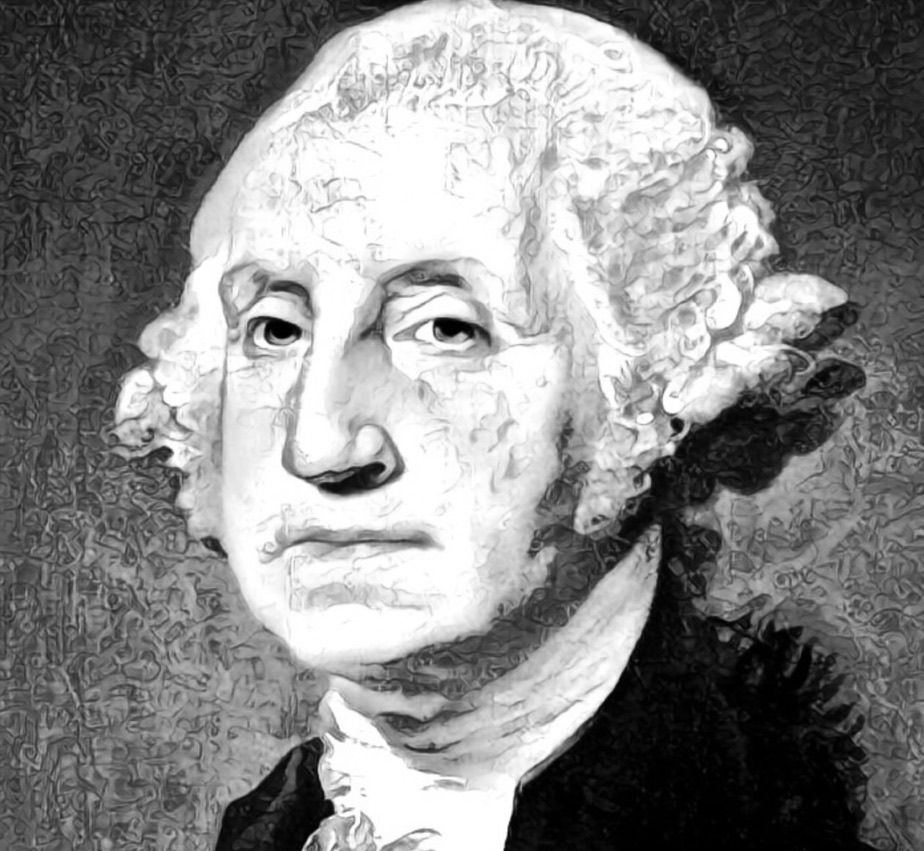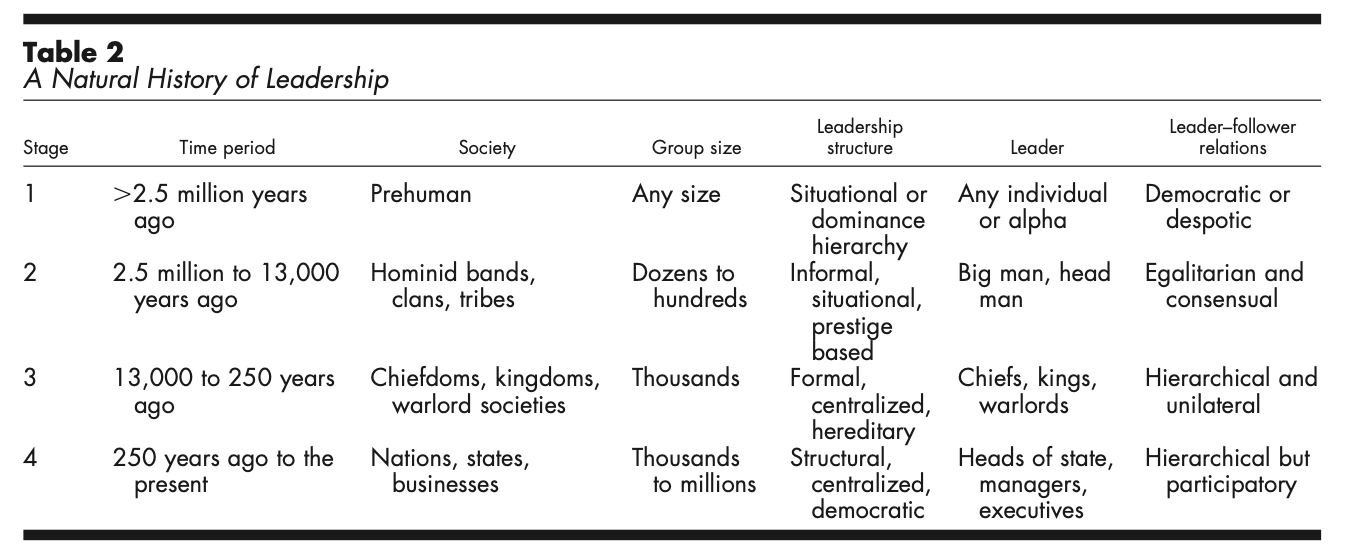The Evolution of Leadership
Our preference for leaders comes from our ancestors.

George Washington was unanimously selected to be the Commander and Chief during the American Revolutionary War. He was thought to be the only person that could unite all 13 colonies.
Having the approval of the wealthy class, the colonial congress, and officers in the military - he brought diverse and often opposing groups together. With his leadership, the colonies were strong enough to fight a war against Britain.
After winning the war, he gave up power and retired. But only a few years later, he was again called by his country to lead. His trusted presence was crucial as the colonies had to start from scratch after the Articles of Confederation failed.
Not only was he unanimously elected to preside over difficult negotiations that created what we now know as our Constitution, but he was also elected to be the first president of the United States.
Even after serving a single term, he contemplated retiring. But many, including John Adams and Thomas Jefferson, urged him to return for a second term to preserve the country.
He eventually served two terms and decided not to run a third. He didn’t want to die in service and set the expectation that presidents should serve for life. Today he is widely seen as one of the greatest presidents in history.
Washington didn’t pursue leadership. It came to him. He was called to lead due to his trusted reputation. During this time, it wasn't easy to trust leaders based on history. How many revolutions ended with the winner of the war deciding to give up power? His actions were not typical, but they were exactly the actions needed to preserve the government long enough to gain stability and see this new nation succeed.
Why did the people at the time have so much trust in him? How was he different from other leaders at the time? In a research paper titled Leadership, Followership, and Evolution: Some Lessons From the Past - The authors use George Washington as an example of a leadership prototype.
They go through leadership progression and explain how it has evolved as we have evolved, taking different forms throughout our history. Looking at leadership from an evolutionary psychology viewpoint, we can understand leadership better.
In this article, I will review the stages of leadership evolution discussed in this paper and conclude with what the authors believe are time-tested leadership characteristics.
Stage 1 - Pre-Human Leadership

Leader/follower behaviors are observed in many non-human species. Examples include foraging insects, schools of fish, and migrating birds.
More complicated leadership behavior emerges in primates. For example, in baboons, when it is time to forage for food, males will initiate the search, but the rest of the group decides who to follow. If no one follows him, he will return to the group, and others will try until a leader is chosen.
The alpha male of chimpanzee groups will “lead the charge” into battle when neighboring groups clash. Chimpanzee alphas also act as peacekeepers when internal disputes break out. Authors write;
"All our closest phylogenetic relatives— chimpanzees, bonobos, and gorillas—practice peacekeeping and it was almost surely a feature of early humans (Boehm, 1999; De Waal, 1996).
De Waal (1996), for example, describes an incident in a chimpanzee community: "A quarrel between Mama and Spin got out of hand and ended in fighting and biting. Numerous apes rushed up to the two warring females and joined in the fray.
A huge knot of fighting, screaming apes rolled around in the sand, until Luit [the alpha male] leapt in and literally beat them apart. He did not choose sides in the conflict, like others; instead anyone who continued to act received a blow from him" "
Leadership is essential in coordinating members among primates, keeping order so the group can focus on finding food and protecting themselves from outside threats.
Even some of the smallest and least complicated animals demonstrate capabilities for leadership. Leadership behaviors evolve uniquely to the specific needs of each species. For humans, this is no different.
Stage 2 - Band and Tribal Leadership
The majority of human history is spent during this time frame (see table above). So it reasons that this stage would have the most dramatic impact on our psychology and affect our current way of thinking.
Group living emerged as a survival strategy. People in well-coordinated groups would be more able to defend themselves, gather resources, and raise their young. Human groups or clans would have been nomadic hunter-gatherers. Groups would comprise of roughly 50-150 individuals.
But with groups brings conflict. For example, it is believed that homicide was the leading cause of death at that time. So peacekeeping (similar to chimpanzees) would have been a valued trait of leaders.
Groups that had less internal fighting could also survive external threats and coordinate to find new resources. Fairness, integrity, competence, good judgment, generosity, humility, and concern for others were values traits in leaders.
Individuals who were too selfish or tried to dominate their groups were met with fierce resistance. Group members did not like tyranny and could band together to stomp it out.
Groups would have had to move periodically to find new resources. This meant that leaders would emerge to take the initiative. In these groups, leaders were specialized. The best warrior and best hunter had a large influence on group decision-making, but it was limited to their domain.
There are still tribes in remote parts of the world that haven’t been modernized where we can see patterns of behaviors that would be consistent with our ancestors. The authors give an example;
"Regarding how the Mae Enga in New Guinea make warfare decisions, Meggitt (1977, p. 76)
The men who initiated the conference, or their spokesmen, briefly indicate their view of the clan’s position and the action they favor.
They may argue that now is the time to launch a full-scale attack on the neighboring clan with the aim of occupying a specific section of its territory. The major Big Man [the leader] then solicits responses from the audience.
Ideally, everyone present has a voice and being among his own clansmen can speak with complete freedom. The task of the Big Man at this stage is to ensure that all have a chance to offer their opinions and facts in full and to make no attempt to cut off any but obviously irrelevant speeches."
As humans evolved and cognitive capacities increased, language and culture enabled groups to form larger tribal structures. As people learned agriculture, they could settle and populations grew as a result.
With growing populations and growing resources, how people organized themselves would change dramatically.
Stage 3 - Chiefs, Kings, and Warlords
During this timeframe, our psychology didn’t change much, but social structures did dramatically.
Agriculture and dependable food supplies enabled groups to settle and populations to grow. This was the first time in our existence that we were able to accumulate resources.
As resources and populations grew, new problems were created that humans weren’t adapted to handle. The demand to allocate resources and inter-group conflict increased, placing an expanded demand on leaders.
Hierarchies and more formalized structures emerged. As power became more concentrated, leaders could use their control of resources to create dedicated followers.
This paved the way for chiefdoms and kingdoms.
Larger group conflict led to the rising of warlords and soldiers classes who built coalitions of followers united in a common purpose of extracting resources by force.
This was one of the concerns the founding fathers had in choosing a Commander in Chief. History had many examples of military leaders using their influence to gain more power.
We can see examples of what this looks like in some parts of the world still who live under these regimes. Warlords use their power to dominate resources, privilege and advance personal interests.
While these leaders effectively achieved their own personal goals at the expense of many others, it conflicts with our evolved leadership psychology and values.
However, human nature would develop new ways of living that would challenge established leadership hierarchies.
Stage 4: State and Business Leadership
This stage starts during the Industrial Revolution and goes to the present day.
Our democratic ideals formed during our earliest stages attempted to achieve some balance in power during this time. Eventually states and nations emerged. Large businesses also developed.
Far from perfect, class warfare was a problem. Still, in the more developed countries, it is drastically decreased compared to parts of the world dominated by warlords.
Citizens and employees were relatively free from the predations of their leaders and may defect to other states or organizations. This freedom shifted power away from leaders.
Modern bureaucratic arrangements may seem to make business sense in today's world. However, the authors believe they still conflict with our psychology. There is evidence that even large organizations perform better when organized in smaller units.
Climate surveys routinely show that 60%-70% of employees in most organizations report that the most stressful aspect of their jobs is their immediate boss, and the failure rate among managers is 50%.
Characteristics of leadership
The authors conclude that a better understanding of our evolved psychology can help modern organizations improve some of the above challenges. They provide six characteristics that we may have a natural preference for in leaders.
Six Evolved leadership prototypes:
- Integrity - good leaders can be trusted
- Prosociality - good leaders are fair and generous
- Humility - good leaders are humble
- Decisiveness - good leaders make sound decisions for the group
- Intelligence and competence - good leaders contribute to the group's performance.
- Vision - good leaders adopt a personalized style and articulate attractive and inspiring group goals
Conclusion
Humans have an evolved leadership psychology based on several million years of living in small communities with an informal, prestige-based leadership structure. Technology and societal changes have drastically outpaced this psychology, leading to challenges and a lack of understanding of leadership.
George Washington was unanimously chosen for different leadership positions in his lifetime when stakes were high. He led during a war for independence, the crafting of our country, and sitting as the first president. He didn't achieve this power by force which was common at the time.
He emerged as a leader, chosen by those around him. Matching the prototype of leaders who would have been chosen by our early ancestors.
References:
- EVOLUTION, LEADERSHIP AND FOLLOWERSHIP Some Lessons from the Past by Mark Van Vugt, Robert Hogan, Robert B. Kaiser - Full Paper
- EVOLUTION, LEADERSHIP AND FOLLOWERSHIP Some Lessons from the Past by Mark Van Vugt, Robert Hogan, Robert B. Kaiser - Article
- Washington: A Life by Ron Chernow
